Under oars or sail, the Heritage 23 is a bewitching sight. The ketch-rigged double-ender, 23′ LOA, is English designer Richard Pierce’s contemporary interpretation of a classic Great Lakes Mackinaw boat, with a sweeping sheer, plumb stem, and raked sternpost. She is the prototype for a comely new one-design class intended to promote rowing and sailing along Michigan’s Sunrise Coast, bordering Lake Huron.
The idea for the Heritage 23 was conceived at East Tawas, Michigan, in 2011. A small cadre led by David Wentworth founded Heritage Coast Rowing and Sailing, Inc., a nonprofit organization. The group’s mission, inspired by the success of the St. Ayles skiff program in Scotland (see Small Boats 2012), is to encourage community boatbuilding, preserve classic regional boat designs, and encourage rowing and sailing. The group commissioned Pierce to adapt a traditional 19th-century Great Lakes boat design to a kit-buildable craft, using marine plywood and epoxy resins. Several boats were considered—among them the Collingwood, Huron, Tawas Bay One-Design, and Bateau—but in the end, the Mackinaw was selected.
Mackinaw boats originated on the Upper Great Lakes sometime in the 1800s, but exactly when has been in dispute for decades. The American Fur Company used Mackinaws on Lake Superior as early as the 1830s. Fishermen on Isle Royale near the lake’s North Shore worked aboard 20′ to 30′ versions of the boat from the 1850s to early 1900s. These Mackinaws were robustly built and heavily ballasted for operating in open waters. Early models, which primarily featured pointed bows and sterns, varied greatly in style, depending on the builder.
Once commissioned by the Heritage group, Pierce studied various plans, including Nelson Zimmer’s 20th-century version of the Mackinaw boat, in preparation for completing his design. Although based on historical Mackinaw lines, the Heritage 23 is designed to be constructed with lightweight modern materials. It weighs just 350 lbs and carries no ballast. With four rowing stations, each for an oarsman handling a single oar, and a coxswain seat, the boat is ideal for competitive coastal racing under oars. As a sailboat, she is best suited for protected waters. Overall, she performs like a large dinghy, rather than a deepwater workboat.
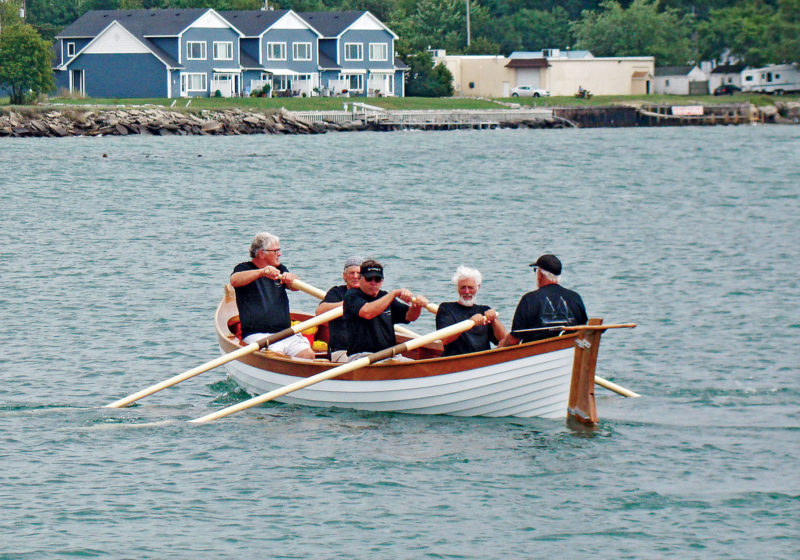 George D. Jepson
George D. JepsonRowing is a particular emphasis of Heritage Coast Rowing and Sailing, and the teamwork involved in having four oars and a coxswain will serve the goal of building community interest in boats and boatbuilding.
After the Heritage 23 plans were drawn, Pierce turned to Alec Jordan at Jordan Boats in Fife, Scotland, to design the prototype kit, as well as the boat’s interior layout, which favors the rowing configuration. Jordan already had a longstanding relationship with Hewes and Company in Blue Hill, Maine, to produce boat kits in North America, and the Heritage 23 has been added to the lineup.
Last April, six amateur boatwrights, regulars who would see the project through to completion, gathered with Jordan in a small building near the East Tawas waterfront. They constructed the Heritage 23 mold, glued garboards to the keel, and the modern Mackinaw began to take shape. During the course of the project, at least two dozen volunteers contributed to the building effort. Four experienced wooden boat builders dropped by almost daily to offer guidance.
As a warmer-than-usual spring hinted at the coming summer, the shop buzzed with activity. The team worked steadily to hang 9-mm okoume marine plywood planks, 12 to a side, gluing the laps with epoxy. “To have consistently hung two pairs of planks a day with a team who mostly had not been involved in building boats is a fantastic achievement,” Jordan said. When the sheer-strake—the “whiskey plank”—was fitted and glued, Jordan and the boatwrights celebrated with “a wee dram” of single-malt Scotch. Although there was much work ahead, it was a major milestone for the boatwrights and their mentor.
In addition to planking, bulkheads, thwarts, and flotation tanks were fashioned from CNC-machine-cut okoume. White oak was used for the keel, keelson, stem, sternpost, inwale, gunwale, tiller, rudder, steering yoke used when rowing, and bowsprit. The centerboard trunk was constructed with a white oak frame, an okoume body, and a sassafras cap. Spars, which included masts, yards, and booms for the standing-lug fore and main sails, were shaped from Douglas fir. The centerboard was cut from 3/4″ aluminum. The boat-builders cut cleats from a white-oak-and-carbon-fiber sandwich that they had laminated.
The Heritage 23 has a traditional-looking finish. The topsides are coated with white epoxy paint. The sheerstrake, thwarts, centerboard trunk, foredeck, spars, yoke, tiller, and rudder are finished bright. The boat is fitted out with off-the-shelf stainless-steel hardware, except for the pintles and gudgeons, which were custom-made locally from aircraft aluminum. Doyle Sails of St. Clair Shores, Michigan, cut Heritage 23’s white Dacron sails.
Raising the Heritage 23’s standing-lug rig is a rather simple matter, and even a novice can do it in about 20 minutes. The two identical unstayed masts (fore and main), with halyards attached, can be seated in their maststeps by one person. Preparing the yards to be sent aloft, the halyard is attached with a rolling hitch. The jib snaps quickly to the bowsprit and the halyard. Connecting the two downhauls, one forward and one just aft of the foremast, and threading the sheets through blocks completes the setup. Breaking down the rig takes even less time. The boat is easily towed or stored on its custom trailer, which Pierce also designed.
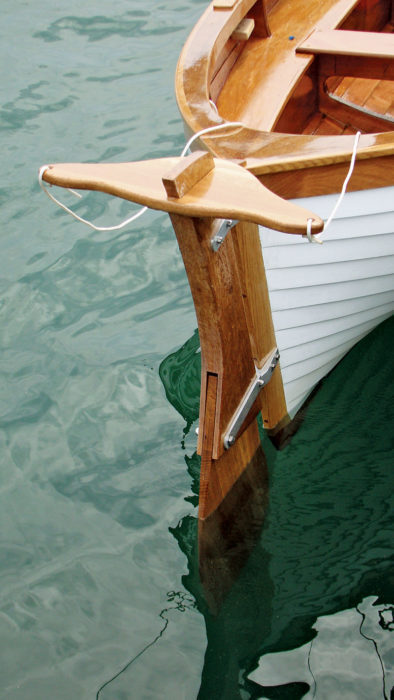 George D. Jepson
George D. JepsonWhen the Heritage 23 is under oars, the tiller is removed and a rudderhead yoke with steering lines is installed to permit the coxswain to sit amidships all the way aft.
By late July, the Heritage 23 was ready to launch Pierce arrived in East Tawas from his home on an island off the coast of Scotland six weeks earlier to shepherd the project through its final steps; Alec Jordan returned to his business in Scotland. On an early August morning, a leaden sky darkened Tawas Bay, while a stiff 15-mph southeasterly breeze whipped the seas into a lively chop. The Heritage 23, with Pierce at the helm and three crew aboard, sliced across the bay under full sail. Emerging from the gloom, she was an apparition from somewhere in time. Turning into the wind, the crew lowered the mizzen, a precaution against potential damage. Even under reduced sail, the boat charged across the cresting waves, heeling to the wind but keeping her lee rail out of the water.
Returning to the harbor behind the protective breakwater, the Heritage 23 glided into her slip. There was water in the bilge and the crew was damp from the spray of the choppy seas. A bit of bailing set things right, while the sailing rig was stowed. Pierce suggested adding a canvas bucket to the regular gear list.
At high noon, the Mackinaw was rigged for rowing, with a steering yoke fixed atop the rudder in place of the tiller. A five-man crew was aboard, including a coxswain. The rowers each grasped a stout 12′ oar. With a word from the coxswain, the pulling began, while he steered by pulling ropes attached to either end of the yoke. Clearly, the pulling crew will need training to achieve a competitive edge, but for the moment they were pleased—along with Pierce—that the hull slid smoothly through the water.
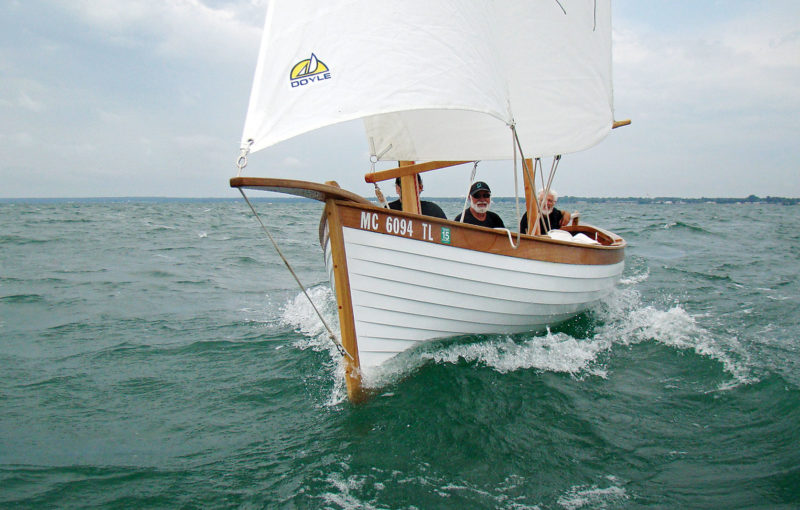 George D. Jepson
George D. JepsonThe Heritage 23 draws on the famous Mackinaw boat of the Great Lakes, with its straight and plump stem, its shapely lapstrake hull, and its two-masted rig with plank bowsprit. The design requirement for glued-plywood kit construction, however, necessitated developing new plans from the bottom up.
By early afternoon, the wind moderated. Once again, Pierce rigged the Heritage 23 with just the jib and foresail, in yet another test of the boat’s capabilities, this time in a light breeze. Clearing the pierhead, we set off on a starboard reach. Tawas Point Lighthouse was visible off the port bow. The designer, still at the helm, was delighted with the boat’s response. In these conditions, a two-person crew could easily handle the Mackinaw for a leisurely daysail. In a heavier blow, with three sails aloft, at least one more hand, if not two, would be preferable.
Taking the tiller from Pierce, I found the helm responsive to my touch. In the light air, there was no weather helm. Pierce remarked that this was also his experience in heavy winds earlier in the day. Coming about, the boat is sluggish due to the long, straight keel that helps her track well under oars. Gaining speed once again, we sailed through the wind and headed off on a port tack. Pierce suggested that I let go of the tiller. Surprisingly, we continued sailing in a straight line, a display of the craft’s tracking ability.
Under sail, the helmsman must sit aft on either the port or starboard bench, just forward of the coxswain’s seat. In this boat, these side seats narrow significantly near the stern, leaving the helmsman with precious little room to comfortably perch. The layout is understandable for rowing purposes, but perhaps a removable thwart would answer.
Heritage Coast plans to build a second Mackinaw this winter, offering an opportunity for a new group of amateur builders to become involved. Along the Sunrise Coast, at least four other community groups are interested in building Heritage 23s.
As more Mackinaws are christened, windows will open to the past—a poignant reminder of the sailors and fishermen who plied these inland seas in small boats a century and more ago. ![]()
Plans and kits are available from Hewes and Company, Marine Division.

The Heritage 23 is an international effort: English yacht designer Richard Pierce paid homage to the Mackinaw boat heritage, but worked in modern elements such as an easy-to-handle standing lug rig, then worked with the Scottish kit-boat developer Jordan Boats to work up specifications for parts cut by Hewes and Company in Maine for a sailing and rowing association based in Michigan.
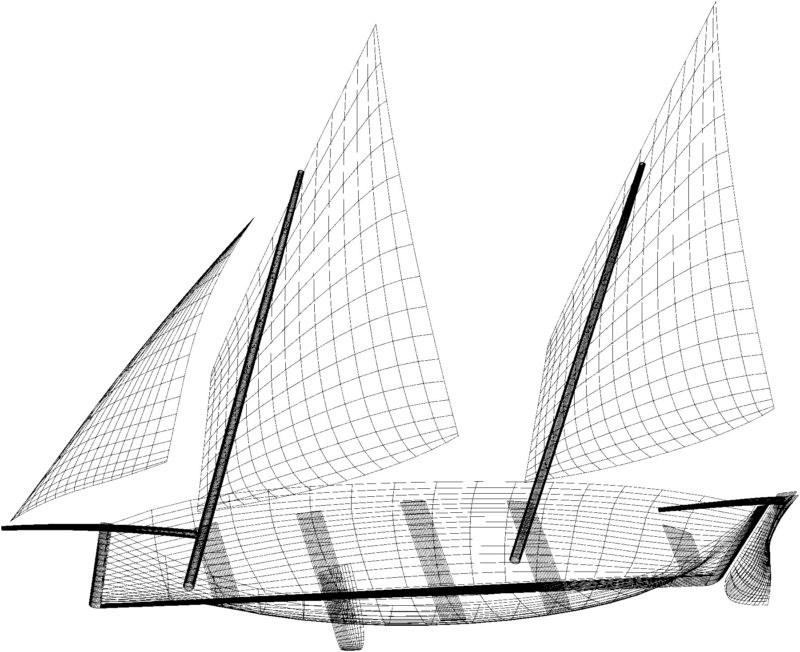
Heritage 23 Particulars: LOA 23′, Beam 5’6″, Draft (db/cb up) 1’2″, (db/cb down) 3′, Weight 350 lbs, Sail area 233 sq ft
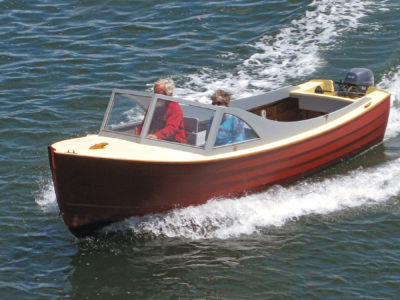
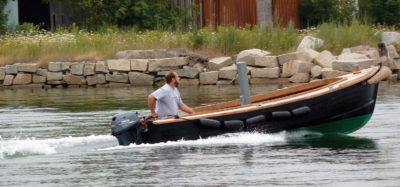

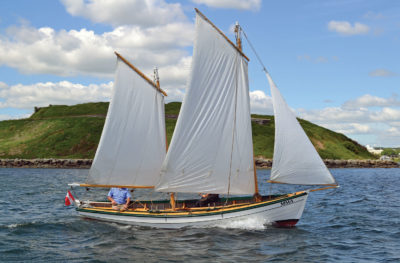
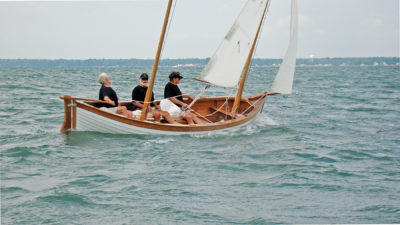
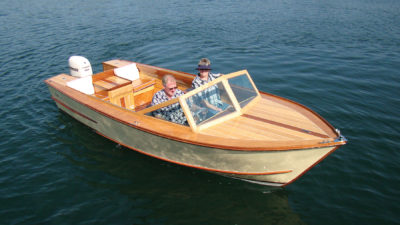
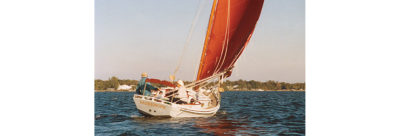
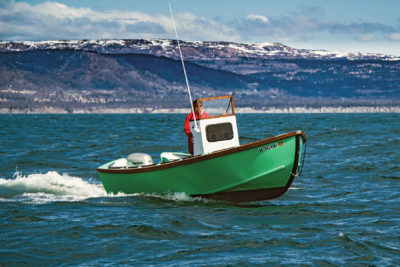
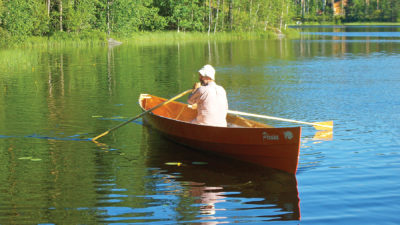
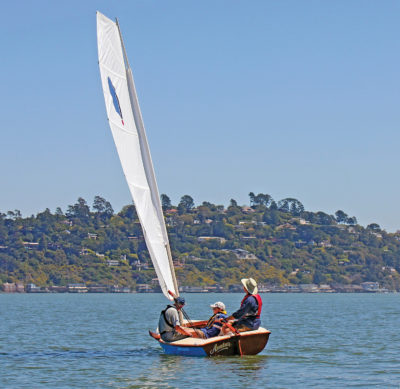
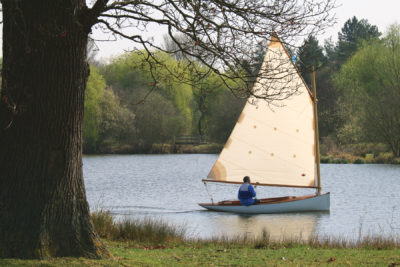
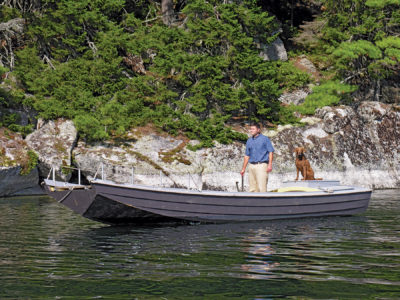
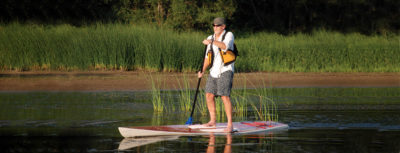
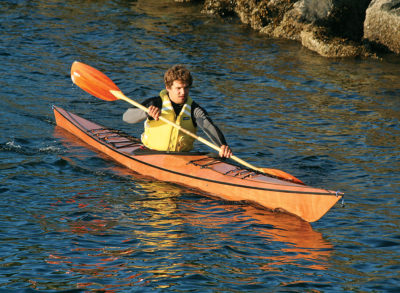
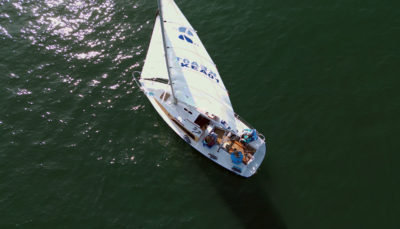
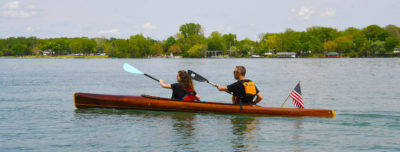

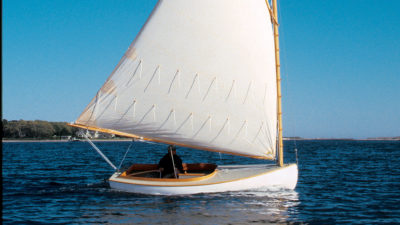
I notice that this article was written in 2013. Any update on how many boats have been built in the past 10 years would be appreciated.
I grew up in Suttons Bay, Michigan, a nice little harbor off Lake Michigan. A boyhood friend of mine’s grandfather was a full-time builder of Mackinaws (in the early ’60s). He worked by himself. He worked fast. I was pretty young to remember the details but I do remember he fastened the strakes using clinched nails, rather than copper rivets or maybe even screws. I also remember people saying that he was the last of his kind, the last builder of Mackinaws.